Shakti - Alive, Nature, Creative Force
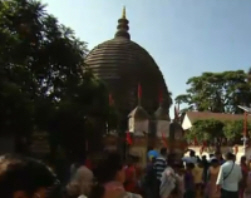
These sacred texts mark a radical new direction in Hinduism - the emergence of an all-conquering goddess who could perform feats that no male God could manage. When it was written in the fifth or sixth centuries AD, the Brahmins, the elite priests in charge of the sacred texts, were consolidating their power in this part of India. To understand what role their arrival here played on the emergence of the goddess, I’m meeting Professor Nilima Chitgopekar.
Nilima Chitgopekar “We found inscriptions were the patrons are giving Brahmins these huge grants of land in areas like Bengal, Orissa, in all, in the eastern area where we are right now, in Assam. They actually started exactly in the fifth century. Now, when those Brahmins must have come here, when they were granted the land, they must have encountered people like this, you know, powerful goddesses. Maybe there was conflict to begin with, but they must have said, hey, we have to incorporate this because it’s not going to go away. And that’s when they incorporated it into their own text.”
The powerful local goddesses encountered in areas like this were gradually accepted into mainstream Hindu religion, and works like the Devi Mahatmyam. And Prof Chitgopekar believes these divine beings were inspired by real women.
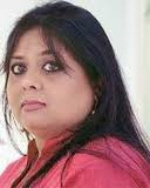
Nilima Chitgopekar “There must have been an army, if not an army, sets of women, who were good with weaponry, who were good at warfare and who are taking part in all that, otherwise you just couldn’t have goddesses like that. You know, religion very often reflects reality in a way, you know? And maybe it’s a forgotten culture of today which has got crystallised in religion.”
Just like those semi-divine females I encountered back in prehistory, Durga’s power comes from a kind of inner life force, found both in the spirit world and in real-life women. The Devi Mahatmyam calls this feminine force Shakti. For the Goddess’s worshippers, Shakti is a kind of subatomic energy and the foundation of life itself, animating every living thing in the universe.
Shakti - The Life Force
Nilima Chitgopekar “Shakti means alive. Shakti means nature. Shakti means creative force, the kinetic energy, the creative force that a woman has within her. The whole idea that she procreates, so she’s the Shakti, and for the followers who come here, it’s not the male God who created this universe. It’s the female.”
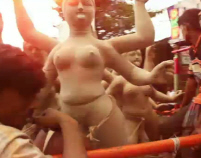
Deep inside the temple of Kamakhya is a secret underground chamber which is particularly sacred for those seeking the blessing of the great Goddess. Her worshippers believe that this cave is the womb or vagina of the Goddess herself. During the Festival of the goddess thousands of Hindus come before dawn, queueing all day for the chance to enter this secret space. I feel incredibly privileged to be able to share their experience. But this site is so sacred, that cameras aren’t allowed, so I’ll have to see you on the other side. That was a fairly extraordinary experience and a very, very hot one because you go right into the temple, deep down into the inner rock-cut sanctum, which is where the whole water of the goddess herself flows.
In the Devi Mahatmyam, the goddess is incarnated in several different forms. The most terrifying is Kali. She emerges when Durga finds herself in an even more desperate battle against another Demon King. Each time the Durga lands a blow on her enemy and you drop off as blood hits the Earth, he’s cloned, until she finds herself battling countless Demon hordes. At the critical point in the battle, a monstrous creature emerges from Durga’s fierce frown. She has daemonic red eyes, her tongue lolls out of her mouth and she is filled with fury. In a murderous rampage, Kali slays the Demon King and his many clones, lapping up their blood.
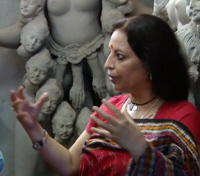
The Hindu texts leave us in no doubt whatsoever as to just how powerful she was. She is described as the beginning of all things, the creator, the protector and the destroyer of all. This terrifying face of the goddess, who can be both the killer and the giver of life, seems to be an incredibly enduring idea. I found it in prehistory at the very beginning of human society and Catalhoyuk, in ancient Phrygia and in Rome. I’m meeting Prof Madhu Khanna to find out how it’s embodied in this Hindu goddess.
Mahdu Khanna “She’s just the anti-thesis, the opposite of Durga, when the battle becomes more and more fierce. She’s Durga’s anger all rolled into one.”
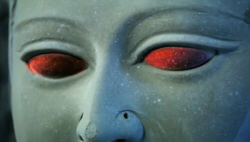
I know from lots of ancient cultures, you often have male gods who vanquished demons or, you know, warriors sent out to kill monsters. So, why here have you got a goddess doing all of that?
Mahdu “But may I ask, why not? She is a mother, a nurturer. In the realms of calamity, she becomes Kali. And what are the reasons why goddess culture has survived is because of the very reconstruction of the notion of femininity which is so unique because she’s an all-embracing goddess. She has a terrific side as well as a big-name side, so all aspects of the human psyche are part and parcel of her personality.”

It’s just interesting for me that those two sides, you know, the terrifying and the maternal and the protective, that we want to see those united in a female figure, in a woman, rather than in a man. A man can be one thing, but I woman can be two things.
Mahdu “A woman can be many things. So, within the Devi Mahatmyam context the goddess is a nurturing mother and she never really loses that role and, at the same time, she can also be fearful.”
After years spent piecing together the goddess’s story from fragments, I want to find out what she means as a real, living force to her followers today.
Politically and economically, India is one of the most successful nations in the world. And despite the massive changes that have swept this country, the goddess seems stronger than ever. I want to know how she fits into this thriving modern society. I have come to Kolkata in Bengal, where her Festival, Durga Puja, has taken over the city. Like most Bengalis, Tanushree Ghosh is celebrating Durga’s Festival. She’s invited me to join her as she gets ready for its finale.
Tanushree is taking me to her community’s pandal, a temporary shrine built especially for the festival.
Every year, thousands of different neighbourhoods, all Kolkata come together to create their own special Durga shrine. Durga’s image is made from clay and water from the sacred Ganges. Described by many as the mother of India, for nine days, she is celebrated, worshipped and treated with the greatest respect.
At the end of the festival, Durga will return home. She’ll be brought to the sacred Ganges, which flows from the Himalayas, the seat of the gods. But first, she must be prepared.
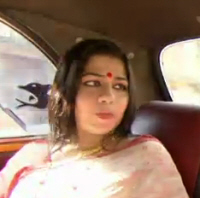
In the ancient world, when women danced ecstatic dances for the goddess, 99% of the time, men weren’t there, so they used to write about it as being these demonic, sad, terrifying occasions. I’ve always had a sneaking suspicion that, actually, the women were having a great time and this seems, to me, to prove it.
We now take the statue of Durga to the Ganges. This is the moment Hindus think she’s starting to return to heaven, to her husband Shiva.
Across the globe, the goddess has pretty much been consigned to history. But, just like those great ancient goddesses of antiquity, here, she is celebrated and worshipped with the wild and heartfelt passion.
